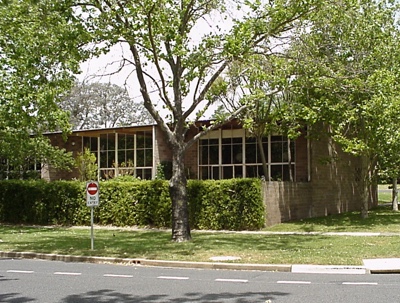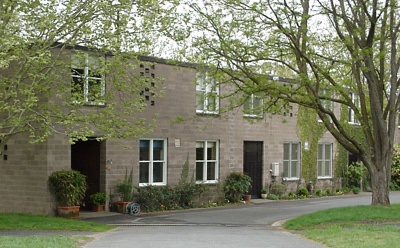Forrest Townhouses, 3 Tasmania Circle, Forrest (1959)

Forrest Townhouses: westernmost townhouse
The Forrest Townhouses at 3 Tasmania Circle, Forrest are a group of five townhouses, a small attached bedsitter and a separate courtyard house linked by carports and a covered walkway. Designed by Roy Grounds as a speculative venture in 1959, they are the only townhouses in Canberra designed by Grounds. Grounds’ own unit was the third townhouse from the west, while the courtyard house was used as the Grounds, Romberg and Boyd office in Canberra as well as the residence of Grounds’ full time architect assistant, Fritz Suenderman and family. The bedsitter was originally leased to a local architectural firm.
The Forrest Townhouses are an important example of the post-war Melbourne regional style with their long unbroken rooflines, widely projecting eaves and glass walls with regularly spaced timber mullions. With their cubiform overall shape and large areas of glazing, the townhouses also exhibit aspects of the post-war international style. They can be compared with other work by Grounds in Canberra: Vasey Crescent houses (1960) and 24 Cobby Street, Campbell (1963–64).
Significance
The Forrest Townhouses are listed on the ACT Chapter of the Australian Institute of Architects (AIA) Register of Significant Twentieth Century Architecture. They are regarded by the AIA as being an important example of the post-war Melbourne regional style and as having a strong association with Roy Grounds. The townhouses are of national significance.
The townhouses are the earliest and probably the only example in Canberra of the design philosophy of Le Corbusier’s Maison Citrohan that includes a double height living space.
Various houses in the group have been owned or occupied by prominent Australians. Apart from Grounds himself, Sir William McMahon, Prime Minister of Australia from 1970–72, lived in the single level courtyard house and Aldo Giurgola, the principle design architect of the New Parliament House, lived in the westernmost townhouse.

View of the rear
Description
The five two storey townhouses are set side by side with high courtyard walls on the north property boundary. The courtyard walls facing Dominion Circuit did not comply with local NCDC guidelines when constructed and were demolished. They were rebuilt at a later date on condition that they be hidden by a planting of bamboo, which remains to this day.
The townhouses have a two storey height living space, which is screened by sliding doors from the dining, kitchen and entry area. Above this is a gallery with a built in desk, which overlooks the living area. Behind the gallery are two bedrooms, a dressing room and a bathroom. The single level courtyard house has a large open living area facing north and opening to a courtyard.
The townhouses are constructed with load bearing concrete blocks, a concrete slab to the ground floor and timber and steel framing to the upper floor and flat metal deck roof. The timber-framed glazing is painted white externally, while interior finishes are low key: face concrete blockwork walls, limed ash joinery and panelling and compressed straw ceilings with exposed rafters and beams.
The Forrest Townhouses were built by Civil and Civic (who also built 42 Vasey Crescent).
Source
- Australian Institute of Architects RSTCA Citation No. R53